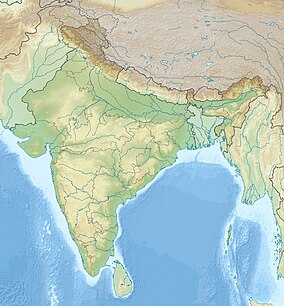
Munger, formerly spelt as Monghyr, is a twin city and a Municipal Corporation situated in the Indian state of Bihar. It is the administrative headquarters of Munger district and Munger Division. Munger was one of the major cities in Eastern India and undivided Bengal during Mughal period and British Raj. It is one of the major political, cultural, educational and commercial center of Bihar and Eastern India. Munger is situated about 180km from east of capital city Patna, about 480km west of Eastern India's largest city Kolkata and 1200km from country's capital New Delhi.
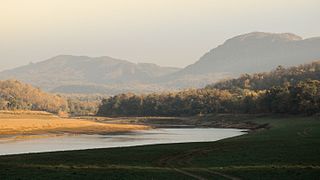
Satpura Tiger Reserve (STR) also known as Satpura National Park is located in the Narmadapuram district of Madhya Pradesh in India. Its name is derived from the Satpura range. It covers an area of 524 km2 (202 sq mi). Satpura National Park, along with the adjoining Bori and Pachmarhi wildlife sanctuaries, provides 2,200 km2 (850 sq mi) of unique central Indian highland ecosystem. It was set up in 1981.
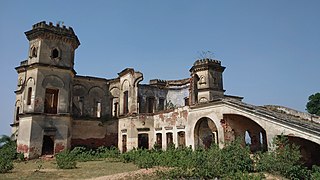
Jamui is a district among 38 districts of Bihar state, India. The district was formed on 21 February 1991, when it was separated from Munger district. It is located at a longitude of 86° 13'E and the latitude is 24° 55'N.

Wayanad Wildlife Sanctuary is a wildlife sanctuary in Wayanad, Kerala, India with an extent of 344.44 km2 (132.99 sq mi) and four hill ranges namely Sulthan Bathery, Muthanga, Kurichiat and Tholpetty. A variety of large wild animals such as gaur, Indian elephant, deer and Bengal tiger are found there. There are also quite a few unusual birds in the sanctuary. In particular, Indian peafowl tend to be very common in the area. Wayanad Wildlife Sanctuary is the second largest wildlife sanctuary in Kerala. It is bestowed with lush green forests and rich wildlife. This wildlife area houses some of the rare and endangered species of both flora and fauna.
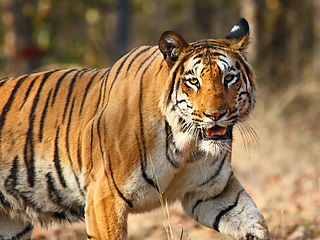
Nagzira wildlife sanctuary is a wildlife sanctuary in the Bhandara and Gondia districts of Maharashtra state in India. It harbours many fish species, 34 species of mammals, 166 species of birds, 36 species of reptiles and four amphibian species. This national park’s invertebrate fauna includes a number of butterflies and other insect species. Large wild mammals present include the Bengal tiger, Indian leopard, gaur, sambar, nilgai, chital, wild boar, sloth bear, Indian muntjac, Indian spotted chevrotain and dhole. It receives nearly 30,000 tourists annually.

Manas National Park is a national park, Project Tiger reserve, and an elephant reserve in Assam, India. Located in the Himalayan foothills, it borders the Royal Manas National Park in Bhutan. The park is known for its rare and endangered endemic wildlife such as the Assam roofed turtle, hispid hare, golden langur and pygmy hog. It also hosts the only known population of pygmy hogs in the world. Manas is also famous for its population of the wild water buffalo. Because of its exceptional biodiversity, scenery, and variety of habitats, Manas National Park is a biosphere reserve and a UNESCO World Heritage Site.
Haveli Kharagpur is a town and One of the three subdivision in Munger district in the indian state of Bihar. Historically it was the centre of the medieval Kharagpur Raj chieftaincy.

The state of Karnataka in South India has a rich diversity of flora and fauna. It has a recorded forest area of 38,720 km2 which constitutes 55% of the geographical area of the state. These forests support 25% of the elephant population and 20% of the tiger population of India. Many regions of Karnataka are still unexplored and new species of flora and fauna are still found.

Andhra Pradesh Forest Department is one of the administrative divisions of Government of Andhra Pradesh. It is headed by the Principal Chief Conservator of Forests, Head of Forest Force. The primary function of this department is protection, conservation and management of forests in the Andhra Pradesh State. The Forest Department is organised into 12 territorial circles and 43 divisions. In addition, one Senior Officer of the rank of Deputy Conservator of Forests functions as Planning and Extension Officer in each district.
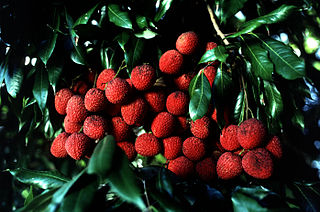
The Indian state of Bihar contains sub-Himalayan foothills and mountains with moist deciduous forests. Rainfall may exceed 1600 millimeters per year. Common trees include Shorea robusta (sal), Toona ciliata, Diospyros melanoxylon (kendu), Boswellia serrata (salai), Terminalia tomentosa (asan), Terminalia bellirica (bahera), Terminalia arjuna (arjun), Pterocarpus marsupium (paisar), Madhuca indica (mahua).

Vikramshila Gangetic Dolphin Sanctuary is located in Bhagalpur District of Bihar, India. The sanctuary is a 60 kilometers stretch of the Ganges River from Sultanganj to Kahalgaon in Bhagalpur district. notified as Vikramshila Gangetic Dolphin Sanctuary in 1991, it is the protected area for the endangered Gangetic dolphins in Asia. Once found in abundance, only a few hundred remain, of which half are found here.

Eturnagaram Wildlife Sanctuary is a wildlife sanctuary located in Eturnagaram village in Mulugu district in Telangana, India. It is located 100 km (62 mi) from Warangal and 250 km (160 mi) from Hyderabad. It is a integrated tribal development town.

Dandeli Wildlife Sanctuary is located at 15°30′23″N74°23′30″E in Uttara Kannada District of Karnataka state in India. The sanctuary covers an area of 866.41 km2 (334.52 sq mi).
Kaimur Wildlife Sanctuary is situated in Kaimur District and Rohtas District of Bihar. It is the largest sanctuary in the state and extended in area of 1,504.96 km2 (581.07 sq mi) in plateaued landscape of Kaimur Range. It was established in 1979. The major forest types are Tropical Dry Mixed Deciduous, Dry Sal Forests, Boswellia Forests and Dry Bamboo Brakes. It is home to rare and endangered flora and fauna. Rohtasgarh Fort and Shergarh Fort are also located in these forests. It also has numerous Megaliths, Rock painting of prehistoric age and stone inscription from a bygone era. The Government of Bihar has planned to developed it into Tiger Reserve.

Nauradehi Wildlife Sanctuary, covering about 1,197 km2 (462 sq mi), is the largest wildlife sanctuary of Madhya Pradesh state in India. This wildlife sanctuary is a part of 5500 km2 of forested landscape. It is located in the centre of the state covering parts of Sagar, Damoh, Narsinghpur, and Raisen Districts. It is about 90 km from Jabalpur and about 56 km from Saugor.

Ramsagar National Park is a national park in Bangladesh located at. 25°33'00"N 88°37'30"E Tejpur, near Dinajpur District in the north-west of the country. The Park is 27.76 hectare, in size, and is built around a large water reservoir known as "Ramsagar tank". The lake is 1079m in length and 192.6m in width. The soil is red-yellow clay
Gautala Autramghat Sanctuary is a protected area of Maharashtra state, India. It lies in the Satmala and Ajantha hill ranges of the Western Ghats, and administratively is in Aurangabad District and Jalgaon District. The wildlife sanctuary was established in 1986 in an existing reserved forest area.
Papikonda National Park is a national park in India, located near Rajamahendravaram in the Papi Hills of the Alluri Sitharama Raju and Eluru districts of Andhra Pradesh, and covering an area of 1,012.86 km2 (391.07 sq mi). It is an Important Bird and Biodiversity Area and home to some endangered species of flora and fauna. No part of Papikonda remains outside East and West Godavari districts after 2014 and the construction of Polavaram Dam.

The Sukhna Wildlife Sanctuary is a 2600 hectare nature preserve located in the Shivalik Hills of Chandigarh, India, near Sukhna Lake. The area was officially declared a wildlife sanctuary in 1998. The sanctuary is open for a select number of visitors, and an entry pass is required, which is issued by the Forest Department Office. The reserve is typically not open to the public during the rainy season.
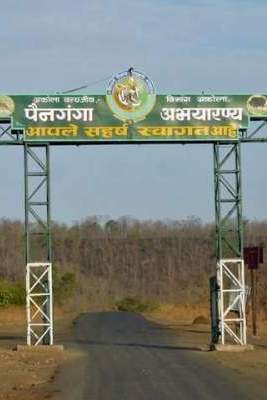
Painganga Wildlife Sanctuary is the name given to the protected forests on both sides of the Painganga River which divides Yavatmal district and Nanded district, Maharashtra, India. The Painganga Wildlife Sanctuary was established on January 1, 1996. It covers an area of about 325 sq. km. in the Pusad forest, in which teak is the main tree. Supervision and direct control is in the hands of the sub-conservator (wildlife) Pandharkavada, reporting to the Government of Maharashtra.
